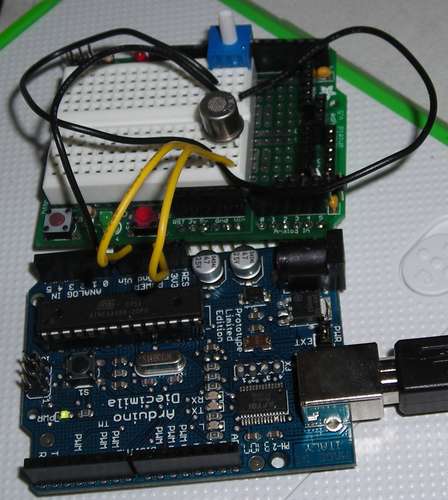
This lets your Arduino smell (and hence you program responses to) overall gas levels for a variety of nasties, including ethanol, methane, formaldehyde, and a bunch of other volatile organic compounds.
My cost to make this actual device was under $100, including the full Arduino kit. Here’s a video:
Demo
And no, I won’t put a shirt on:-)
I’ve got kits / finished versions of this and some other projectsfor sale @ my website
The closest comparable commercial products I can find are:
–a commercial-quality detector: $2500+
–a lab monitor: $295
–a one-off test kit for volatile organic compounds: $234
I learned about this after hearing about some guys who added VOC sensors to toy dogs. Not sure where/if the docs on that project are, but here’s the guide that I followed.
Links explaining what VOCs are and why you might want to care:
–Some symptoms of overexposure to VOCs
–an OSHA regulation on formaldehyde levels
–information on sick building syndrome: ‘A 1984 World Health Organization Committee report suggested that up to 30 percent of new and remodeled buildings worldwide may be the subject of excessive complaints related to indoor air quality (IAQ).’
–The Inside Story: A Guide to Indoor Air Quality: “For pollutants other than radon, measurements are most appropriate when there are either health symptoms or signs of poor ventilation and specific sources or pollutants have been identified as possible causes of indoor air quality problems. Testing for many pollutants can be expensive. Before monitoring your home for pollutants besides radon, consult your state or local health department or professionals who have experience in solving indoor air quality problems in non-industrial buildings.”
Step 1 Gather Your Supplies
You’ll need:
-an Arduino (or equivalent)
-a cable to hook the Arduino up to your computer / provide power
-a computer to read values
-a potentiometer or resistor of known value. anywhere from 500-1k ohms should work
-the gas sensor: a pain to buy in small quantities. i bought 2 and they cost like $22 each, but volume orders get way cheaper… the specific sensor i used was figaro sensors’s 2620.
Here’s what I used:
–the arduino kit I used
–the different sensors available from Figaro (use different sensors to ‘smell’ different things)
It’ useful but not necessary to have a multimeter and wire stripper handy…
The pdf included with this step is the price list from the sensor manufacturer as of March 2008.
Step 2 Set Up Your Arduino
1. Get your Arduino connected to your computer and functional
This should be pretty straightforward, especially with any newer Arduino. This guide worked for me.
2. Program your Arduino to read the value from an analog input and display this on-screen. I used
–this guide for using a potentiometer with an arduino and basically just modified the frequency with which it reads input value (delay(100) = read 10 times per second) to get the following code, which works for me:
//this outputs pot value to screen in ohms
int gasSensor = 0; // select input pin for gasSensor
int val = 0; // variable to store the value coming from the sensor
void setup() {
Serial.begin(9600);
}
void loop() {
val = analogRead(gasSensor); // read the value from the pot
Serial.println( val );
delay(100);
}
If you’re using this as your first excuse to play with an Arduino, you might want to try just wiring up the potentiometer and reading the value from it before adding the sensor.
Step 3 Create Your Circuit

For the 2620, the datasheet specifies at least 450 ohms resistance needed. I tuned my potentiometer to ~right around 450 ohms.
In plain english, here are the connections you’ll want to make:
-sensor pin 1 to an outer pin of potentiometer and ground (arduino ground)
-sensor pin 2 to other outer pin of potentiometer
-sensor pin 3 to arduino +5 v and sensor pin 4
-middle pin of potentiometer to arduino analog 0 input
You can solder this (read Figaro note on which type of solder and temperature exposure of sensors), but a breadboard is good enough for my purposes.
For more Detail: How To Smell Pollutants
